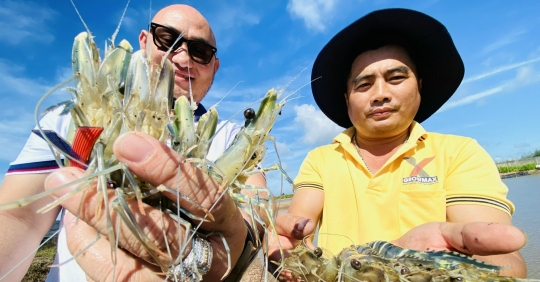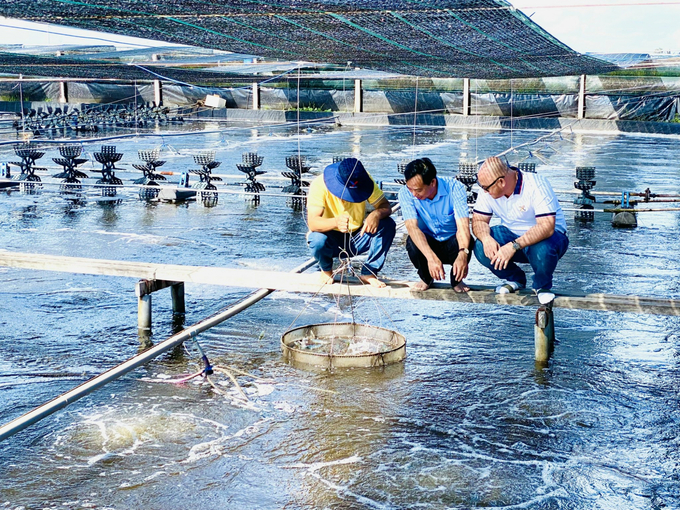
Bac Lieu develops high-tech shrimp farming models divided into 2-3 phases that adapt to climate change. Picture: Le Hoang Vu.
Super intensive shrimp farming
Everyone has known for a long time that Bac Lieu is the main shrimp farming “capital” of the country. In recent years, Bac Lieu has always chosen shrimp as the main destination for domestic market and export, thus contributing to local economic development.
As Bac Lieu was determined to become the center of the country’s shrimp industry, shrimp farming in Bac Lieu has made significant strides, advanced techniques have been boldly applied by farmers to cope with the weather extremes, limit the risks posed by epidemics and to bring high economic efficiency. This model gradually spread and was encouraged by the province to submit an application to promote the development of the local shrimp industry, which deserves to be the shrimp “capital” of the country.
According to statistics from the Ministry of Agriculture and Rural Development of Bac Lieu, the total area of shrimp farming in the province is about 145,000 hectares, of which super-intensive shrimp farming is over 1,800 hectares, the water area for agriculture is 18522 hectares, with 1,600 ponds/reservoir. Advantages of the super-intensive Vannamei culture model in circular swimming ponds achieve survival rates of 70-90%. Limiting the entry of diseases into the agricultural area by restricting pumping of new water directly from rivers and canals and pumping of drains to the outside environment, helping to protect the environment.
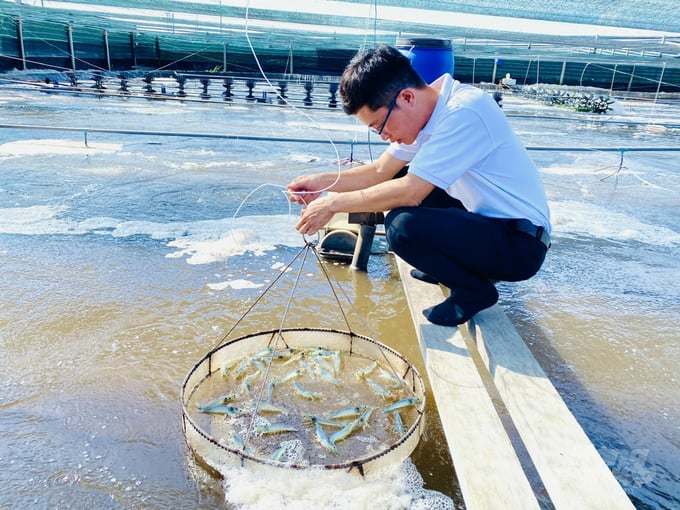
High-tech shrimp farming is three times more profitable than traditional shrimp farming outside of earth ponds.
With this farming method, super-intensive Vannamei shrimp yields 50-55 tons/ha, the profit is about VND 2 billion/ha, three times higher than traditional shrimp farming outside soil ponds.
Mr. Hoang Van Hai from Bien Tay A Hamlet, Vinh Trach Dong Township, Bac Lieu City (Bac Lieu), who had many years of experience in traditional shrimp farming, invested in the switch to super-intensive shrimp farming -tech application for 2 years. Mr. Hai said his family owns 3 hectares of land for shrimp farming, which he invested in designing 2 high-tech ponds and 1 clarification pond. On average, each pond is 1,400 m2 wide and uses new breeding techniques in 2-3 phases, depending on the season, to support shrimp rapid growth and reduce diseases. Therefore, many shrimp cultures through his family are always more successful and profitable than the previous traditional breeding method by 30-40%.
According to Mr. Hai, high-tech shrimp farming, although the initial investment is high, but there are many good things later, such as combating pollution of the water source in the lake, shrimp keepers do not walk along the shore, so they do not infect diseases like the agricultural model in the earth pond. At the same time there is less wading in the pond, which means that the bottom of the pond is very good. Not only that, it also saves electricity and water and is easy to manage with other farming techniques.
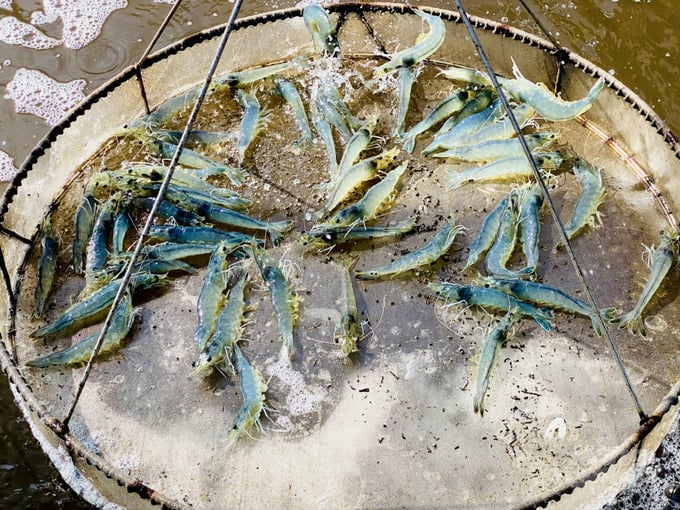
Advantages of the super-intensive Vannamei culture model in circular swimming ponds achieve survival rates of 70-90%. Picture: Le Hoang Vu.
In particular, super-intensive shrimp farming minimizes the phenomenon of premature shrimp death in the period of 25 to 30 days after stocking (AHDNP, acute hepatopancreatic necrosis disease), on average 3 to 4 shrimp crops can be stocked per year. This model does not use antibiotics and chemicals in the breeding process, has little negative impact on the environment, creates a safe pond environment for shrimp growth and limits diseases. High stocking density of 150-300 fish/m2, short rearing period of 2.5 – 3.5 months can be harvested and sold.
Mr. Hai added that in the last shrimp harvest, he raised 2 ponds from the beginning of the harvest to the end of the season, using all the feed products from GrowMax, so that the shrimp grow up quickly and with less diseases, which is the loss rate per capita was reduced, rather large. Therefore, his 2 shrimp ponds harvested over 15 tons, after deducting all expenses, he made a profit of over VND 1 billion.
Adaptation to climate change
And Mr. Tran Tuan Em has 8 high-tech floating shrimp farming ponds (less than 2km away from Mr. Hoang Van Hai’s shrimp farm) and the application of GrowMax company water filtration cycle system to help the implementation. On average, each pond is 500 m2 wide, he just finished the second shrimp harvest and released the third batch. This breeding season, he chose the GrowMax company feed from the beginning to the end of the season and noticed that the shrimp were large and vigorous, eats good, the water color was clear, green, stable, no foam… thanks to the reusable water filter system, his family’s shrimp ponds don’t need to change new water, saving a lot of water costs in terms of labor, electricity, good management of water resources for the Shrimp farming, convenient care. Mr. Tuan Em confirmed that the yield is 30-40% higher than traditional soil pond farming.
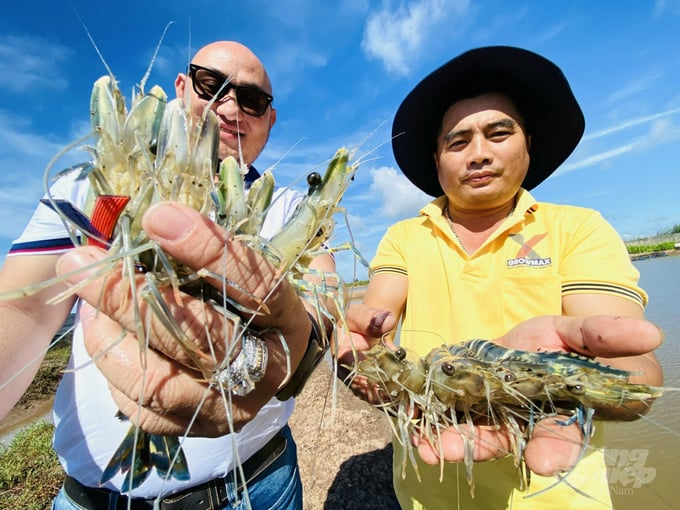
High-tech shrimp farming, feeding shrimp with GrowMax industrial feed helps stabilize the water environment, with less water, shrimp grow quickly, and the head loss rate is much lower than conventional farming. Picture: Le Hoang Vu.
Thanks to innovative shrimp farming with high technology to adapt to climate change, farmers have more security, shrimp are less sick, and the efficiency is high. Mr. Tran Tuan’s new farming model can plant in many stages on average every year and harvest 8 to 9 batches of shrimp per year, with an average yield of 60 – 70 tons, bringing in billions of revenue copper. Especially for the shrimp breeding season, he feeds the shrimp with industrial feed from the company GrowMax, according to the feed coefficient 1.3 (an average of 1.3 kg of feed gives 1 kg of commercial shrimp), the shrimp price is currently at a good level. Mr. Tran Tuan I breed shrimp weighing 25-26 heads/kg before harvest, production is estimated at over 2.6 tons shrimp/500m2 pond, selling for 200,000 VND/kg, after deducting all possible costs 40 %.
Mr. Cao Thanh Van, Chairman of the Board of Artemia Vinh Chau – Bac Lieu Cooperative in Vinh Trach Dong Township, Bac Lieu City (Bac Lieu), said: The cooperative was established in 2003, 11 hectares of land with 18 hectares of land is allocated by the state to to invest in the development of Artemia and shrimp farming. For almost 3 years, the cooperative has boldly invested in a high-tech shrimp farming model covering an area of 5,000 m2, linked to climate change adaptation.

High-tech shrimp farming, although the initial investment is high, but later there are many good things, such as combating pollution of the water sources raised in the lake, shrimp grow quickly, and there are few diseases… Photo: Le Hoang Vu.
On average, building 1 hectare of super-intensive Vannamei shrimp requires about VND 3 billion to build a net house to cover the shrimp pond, line the bottom of the pond with tarpaulins, install a buoy system, soil oxygen, feed, water medicine, and fish alike . During the rearing process, the shrimp feeding is completely mechanical, so the shrimp eat continuously, which limits the feed that stays in the water for a long time, pollutes the pond bottom… With this method, the shrimp develop evenly.,Increasing productivity by 2- 3 times compared to intensive shrimp farming in soil ponds.
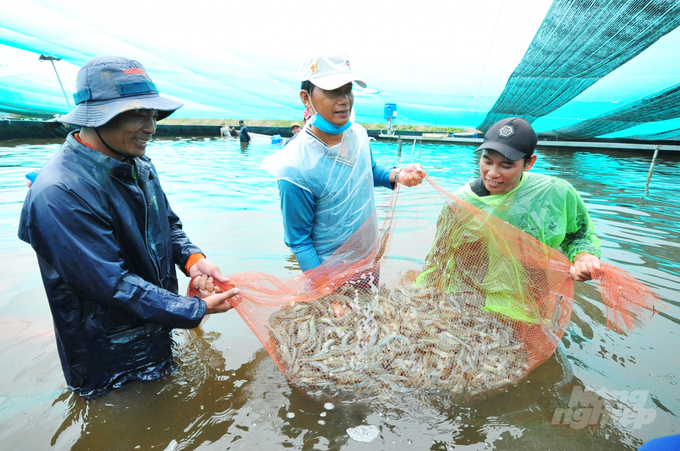
This year, shrimp prices are quite stable, high-tech shrimp farmers in Bac Lieu are very excited. Picture: Le Hoang Vu.
According to Mr. Luu Hoang Ly, director of the Bac Lieu Ministry of Agriculture and Rural Development, the province is developing high-tech shrimp farming models, divided into 2-3 stages, which adapt to climate change. The Bac Lieu agricultural sector considers these to be typical models that need to be further replicated. With the impact of the high-tech shrimp farming model, there is a need to promote development to help farmers increase the success rate and contribute to the sustainable development of Bac Lieu Province aquaculture industry in the near future.

